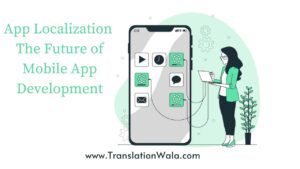App localization: Today’s international world gives app makers more chances than ever to reach people all over the world. But changing your app into different languages isn’t enough to make sure it will do well in new areas. To really be successful, you need to “localize” your app, which means making changes to it so that it works with the language and culture of each target market.
What is App Localization?
The act of modifying an application so that it may be used in a certain country or market is known as “App Localization.” This involves converting the app’s content into the target language, modifying the user interface (UI), and checking that the program is in accordance with the laws of the target country.
Why Localize Your App?
There are a lot of reasons why you should localize your software, including the following:
- Increased user engagement: Users are more likely to use an app and interact with it when they get the impression that the app was designed just for them.
- Improved app store rankings: App shops often rank locally made apps higher, which makes them easier for people who want to use them to find.
- Expanded market reach: You can reach new users and areas by localizing your app.
- Increased revenue: When apps are localized, users are more likely to buy in-app things and improvements, which can bring in more money.
How to Localize Your App
The process of localizing your app might be hard, but it’s worth the work. The following are some of the most critical steps:
- Identify your target markets:
You need to know who you want to use your app before you start localizing it. This will help you focus your work and make sure that your translation efforts are useful to the people you want to reach.
- Conduct cultural research:
When you know who your target market is, you need to do culture study to learn about their cultural norms and sensitive areas. This will help you make sure your app doesn’t offend anyone culturally.
- Translate your app:
Text localization is the most important part of app translation. This should be done by trained translators who can speak both the source language and the target language well.
- Adapt the UI:
The UI of your app should also be made to fit the people you want to use it. This could mean making changes to the colors, styles, and layout.
- Test your app:
After translating your app into the local language, you should test it carefully to make sure it works well and is fit for the culture.
- Monitor and update your app:
App translation is a process that never ends. You need to keep an eye on how well your app is doing in each area and make changes as needed.
Extra Helpful Advice for Success
- Involve native speakers in the localization process: Native speakers can give you useful feedback on how accurate and culturally appropriate your versions are.
- Use localization tools: There are a number of tools for translation that can help you handle the process.
- Get buy-in from your team: Localization takes work from a group. Everyone on your team should know how important translation is and want to see it through to the end.
Conclusion
The process of App localization is a necessary step for every app developer that want to be successful in new geographic markets. You can ensure that your app is correctly localized, that you reach more people, and that you achieve your business objectives by following the advice provided in this blog article and putting it into practice.



